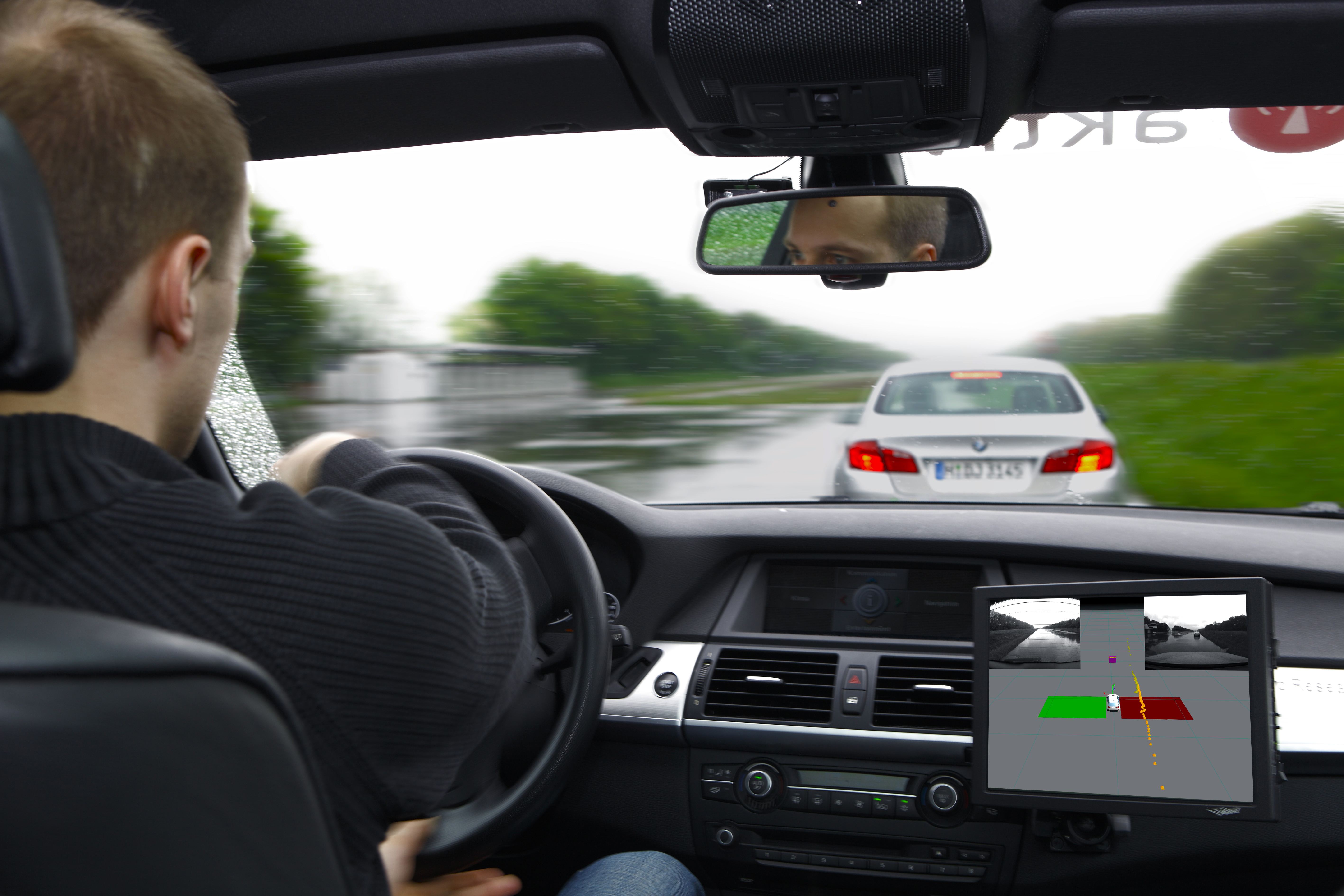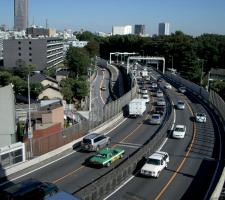
Most of the major auto manufacturers have been engaged in cooperative infrastructure research for quite some years now. Here a test vehicle from the German Aktiv project demonstrates a braking application for collision avoidance (Picture: BMW)
Despite much research and technological promise, progress towards cooperative infrastructure system deployment is still slow. Here, Robert Cone and John Miles take a considered look at how and when it might come about
From a systems engineering viewpoint it looks logical and inevitable that vehicles should be communicating between themselves and with the road infrastructure. But seen from a business viewpoint the case is not proven.An effective road network is critical to any modern economy and the infrastructure is a utility that needs a control system like any other. Users demand reliable, predictable and safe journeys. The network is organised into destination nodes, local distribution services and trunk connections. If there is an obstruction or failure, action has to be taken to re-route or delay traffic.
The road network is unique in that the owner of the network, the road operator, has no control over its users, who are largely free to choose their own routes and journey times. The road operator has to work to influence users by providing information which allows them to make the most appropriate travel and driving decisions. Without Vehicle-to-Infrastructure (V2I) communications this information can only be provided at fixed points (signs) or times (radio). The recipient of the information is also the driver rather than the vehicle and so the effectiveness of these interventions is never sure.
The vehicle itself has changed over the last few decades. Computing and communications technologies make it more efficient and safer. It is increasingly common for electronic systems to assist with control or even take over completely some functions, although in Western Europe most drivers stubbornly exert their right to a clutch and gearstick.
Vehicle manufacturers have developed a sophisticated machine which optimises performance but has little knowledge about the surrounding network or the behaviour of nearby traffic. More intelligence would enable the vehicle not only to further optimise performance but also to anticipate events and help with the driving task. Since the early days of DRIVE and PROMETHEUS there have been many demonstrations and proofs of concept which have shown the benefits of connected technologies. Over the last 30 years the technology has become smaller, faster and cheaper but the fundamental applications have changed little. Most now agree that technology is not an issue and there are many applications which have been tried, tested and shown to have value. However, only in Japan are connected systems rolled out in any quantity. What should be driving this deployment? The PIARC-FISITA Joint Task Force provides a global forum for consideration of these issues, bringing together the road operators (from
Data and information applications
The modern road operator is in possession of a great deal of strategic network information. This is wide-area information about traffic patterns, forecasts and works or events which may impact on the network. In congested or closely controlled areas the operator may also have very detailed information about traffic conditions and behaviour.The vehicle has a different dataset relating to very local conditions. It knows its location through GPS, its speed, the way it is being driven and, with SatNav, the journey plan. More complex information may be available from vehicle systems and sensors, such as weather, road condition or road friction. Information from a sample of the vehicle population could be used to fill significant gaps in the infrastructure operator's knowledge base.
Vehicles carry information relevant to those nearby. Information such as the need to brake rapidly could be used by vehicles behind to help travel as efficiently as possible or even avoid accidents. As a spin-off, inter-connecting vehicles may also bring specific benefits to freight and social networking applications.
Finally, vehicles also carry data relevant to the automotive sector. Onboard instrumentation can provide information about vehicle condition or service requirements. It can also provide data about the vehicle's driver and the driver's lifestyle, a controversial issue.
Whilst anonymous information is satisfactory for operating the road network, personal information is likely to be much more valuable for commercial operations. The public has diverse views on this. Younger members of the population are more prepared to allow details of their lives and movements to be made public and used for targeted advertising and other services. The experience of mobile telephone and credit card usage suggests that few are prepared to forego the advantages of these technologies in order to remain private.
Routes to deployment
In general, there are four contenders which could take a lead in deployment: national governments, local authorities, and the telecommunications and automotive industries.Japan's VICS has shown that the government-led approach can result in significant uptake of connected systems. VICS connects with vehicles through infrared beacons in urban areas as part of the police-led Universal Traffic Management System. On freeways, microwave DSRC beacons have been installed to carry travel information and for electronic toll payments.
However, there is little sign that other governments will follow this lead. Cooperative systems demand both capital investment and revenue expenditure. Current restraints on public expenditure make it inevitable that the focus must be on the core task of providing and maintaining the network.
In general governments prefer to support R&D and standardisation, relying on industry to deploy and exploit these technologies. But even in these hard economic times road safety remains important and might justify doing more. There is a public case for investing in road safety; people require mobility but not the suffering and hardship resulting from collisions. There is also a strong, but complicated, economic case which takes into account both the direct (healthcare) and indirect (loss of earnings) costs. There may be a case for governments to lead and promote active, communications-led, safety applications.
The safety case is being seriously considered in the USA along with suggestions that basic safety functions be mandated as early as 2013.
Many local authorities have the facilities and powers to introduce connected systems. Authorities have been actively engaged in pilots and demonstrations designed to test technical feasibility and develop the business case. But for authorities to actively promote these systems, this case must be strong. A June 2010 position paper from POLIS suggests that whilst cooperative systems promise benefits there are other ways of achieving their objectives. For many authorities, improving the effectiveness of car-based transport is not the key objective. Their emphasis is on improving the environment, quality of life and overall transport efficiency by encouraging transport using other modes. Again, in tough times it seems unlikely that local authority funds will be available to drive connected technologies - although they have demonstrated a willingness to become active partners.
There are a growing number of portable, smartphone and SatNav devices which provide platforms for connected applications. These, combined with a significant, global increase in mobile bandwidth, set up the opportunity for the development of some interesting mobile applications able to help drivers to avoid congestion, optimise routing and make payments for services. These applications may benefit some consumers and will certainly make money for the telecommunications industries. They may not address the policy issues important to governments. In fact there may be a strong negative effect on safety as a consequence of poor interface design and more driver distraction.
Revenue applications, particularly those related to road user and congestion charging, might provide a channel for communications-led service development, particularly for freight. In some countries security and revenue applications are important, particularly to commercial vehicle operations. Moreover, this decade has been marked by the emergence of social networking and 'chat' systems. Is it likely that people will demand more interactive capability whilst mobile as they did in the early years of CB radio?
At first sight the automotive sector might not seem the most likely candidate to propose connected systems. The increasing technology embedded in the modern vehicle provides the need and opportunity for manufacturers and dealers to keep in close contact with their customers. Some manufacturers already market connected applications associated with customer services, service plans and remote condition monitoring. Further applications are being developed which use this cellular connectivity to improve their understanding of their customers and obtain data about vehicle use and network conditions.
In the longer term, as vehicles become more comprehensively instrumented in order to help the driver to optimise performance and avoid collisions, manufacturers may start to share data with other vehicles using short-range wireless communications. It has been shown to be technically feasible but there will be a cautious approach because of commercial and legal issues.
The way forward
Presently, it seems unlikely that any one of these deployment paths will dominate and trigger rapid roll-out. Development will more likely be incremental and progress on several fronts.The existing telecommunications networks provide a mechanism for the early rollout of the next generation of connected applications. Navigation systems suppliers already work with subscribers and authorities to provide better coordinated and connected navigation information. The telecommunications and IT industries are starting to develop new applications and business models based around smartphones and consumer technology. The automotive industry is already engaged here.
However, the safety and efficiency case is built on the macro-economic benefits to society. Full vehicle-to-vehicle and V2I connectivity would make the entire system more efficient, safer and cleaner. There is evidence that these benefits are real and worthwhile but at the moment they are insufficiently compelling for any one player. Furthermore, the available commercial wireless telecommunication systems do not provide the level of service required for most safety and efficiency applications. Communications technologies such as DSRC will have to be deployed, meaning additional cost and investment for both consumers and infrastructure.
Japan has set out a clear mission: to build on its successful VICS to introduce safety-related applications. It is likely that other governments will cautiously and progressively introduce connected functions into regulation which will improve safety and environmental efficiency. The USA has its 2013 decision; Europe has focused much research on e-Safety.
At the moment the drivers in industry and government are seeing red signals. It is difficult to predict when the lights will change. The connected vehicle, of course, will know and be prepared and ready to move on safely at the appropriate time. What is certain is that the next generation of vehicles will make more use of technology to become more efficient and less polluting. It will be the vehicle, not the driver, which communicates with the roadside infrastructure to form part of an engineering system. This vehicle will take over or assist more of the driving functions, taking society closer to 'zero tolerance', the vision that collisions do not occur.










